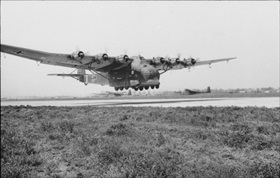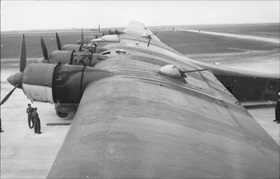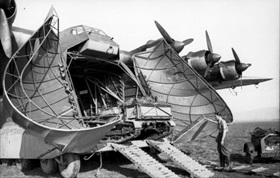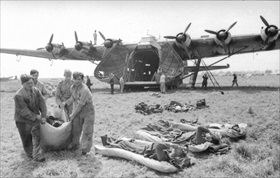FIRST FLIGHT OF NAZI MONSTER TRANSPORTER
Berlin, Germany · February 25, 1941
The first flight of the German prototype Me 321 Gigant (“Giant”) took place on this date in 1941. The previous October German aircraft maker Messerschmitt had been given just 14 days to submit a proposal for a large-capacity troop- and cargo-carrying glider. The prototype glider’s maiden flight encouraged Messerschmitt to enlarge the cockpit to accommodate a co-pilot and a radio operator and add electric servo motors to assist the pilots in moving the huge trailing edge flaps. Placed in service too late for use in Operation Sea Lion, the planned invasion of England which was cancelled, the Me 321 was put to use in Operation Barbarossa, the Russian campaign that began in June 1941.
Standing over 33 ft/10 m tall, made of steel tubing, wooden spars, and covered in doped fabric, with clamshell doors in the nose and massive high-mounted wings that stretched 181 ft/55 m, the aircraft could carry in its boxcar-sized belly a combination of 120–130 fully equipped troops, or 60 stretcher cases with medical attendants, or an 88mm gun and tractor, a medium tank, or two 4–ton trucks. The biggest land-based cargo aircraft of World War II, some 200 were built between June 1941 and April 1942, seeing considerable service on the Eastern Front. (They were withdrawn in the spring of 1942 in anticipation of the invasion of Britain’s Mediterranean island fortress, Malta.) Me 321 gliders were to have been used to rescue Gen. Friedrich Paulus’ besieged German Sixth Army at Stalingrad, but by the time they were returned to the front lines in January 1943, no suitable airfields remained and so they were towed back to Germany. A similar problem with finding suitable landing sites prevented the gliders’ use in Sicily during the Allies’ successful Operation Husky in 1943.
Another 200 or so six-engine variants of the Me 321, with a strengthened wing and designated the Me 323, were built between 1942 and 1944. The Me 323 “D” series had a crew of five (the original two pilots and radio operator were augmented by two flight engineers) and was armed with five 13mm machine guns. Maximum payload was around 20 tons with a range of 500 miles/805 km flying at 136 mph/218 kph. Four liquid-fuel rockets assisted takeoff. An invaluable asset to the Germans, Me 323s saw service in Tunisia, Italy, and on the Eastern Front.
![]()
Messerschmitt Me 323 Gigant (“Giant”), Powered Variant of the Me 321 Military Glider
 |  |
Left: A motorized variant of the Messerschmitt Me 321, the Me 323 was the largest land-based transport aircraft of World War II. Around 200 of these lumbering, six-engine aircraft were built before production ceased in April 1944. It is believed that no Me 323s survived in service beyond the summer of 1944. A ruined but complete wreck was found in 2012 off the coast of Sardinia, Italy.
![]()
Right: This photograph from March 1944 shows an Me 323 with multiple machine-gun turrets. Among the mounted guns were the 7.92mm drum magazine MG 15 and the belt-fed MG 81 or the belt-fed 13mm MG 131. The MG 81 could fire between 1,400 and 1,600 rounds per minute.
 |  |
Left: An Me 323 unloading a Renault UE Chenillette, a light tracked armored carrier, Tunisia, January 1943.
![]()
Right: The monster airplane ferried troops, equipment, and fuel (up to 52 drums), and evacuated the wounded as shown in this photograph taken in Italy in March 1943.
History of the Messerschmitt Me 323 Gigant (“Giant”), 1942–1944, the Powered Variant of the Me 321 Military Glider (Ignore first 20 seconds)
![]()

 History buffs, there is good news! The Daily Chronicles of World War II is now available as an ebook for $4.99 on Amazon.com. Containing a year’s worth of dated entries from this website, the ebook brings the story of this tumultuous era to life in a compelling, authoritative, and succinct manner. Featuring inventive navigation aids, the ebook enables readers to instantly move forward or backward by month and date to different dated entries. Simple and elegant! Click
History buffs, there is good news! The Daily Chronicles of World War II is now available as an ebook for $4.99 on Amazon.com. Containing a year’s worth of dated entries from this website, the ebook brings the story of this tumultuous era to life in a compelling, authoritative, and succinct manner. Featuring inventive navigation aids, the ebook enables readers to instantly move forward or backward by month and date to different dated entries. Simple and elegant! Click 











